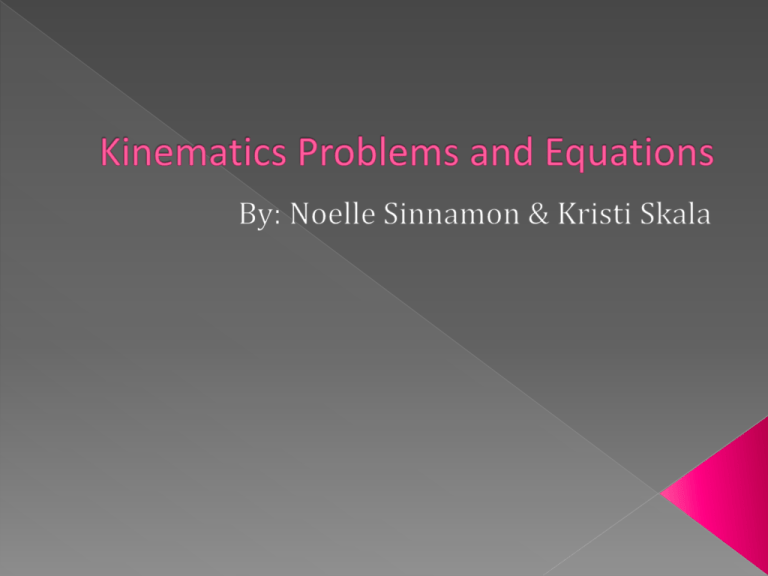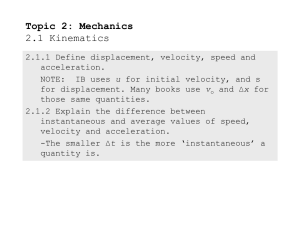Kinematics Problems and Equations
advertisement

Mechanics: The study of motion of objects ;] Kinematics… WHAT IS THAT? › The science of describing the motion of objects Measure by using graphs, diagrams, numbers, and equations Scalars- quantities that are fully explained by magnitude alone Vectors- quantities that are explained by magnitude and direction › THE SIGN MATTERS! The sign matters b/c it determines the direction of the object Distance and displacement both show how an object moves › Distance is a scalar and shows the amount of distance covered › Displacement is a vector and shows the overall change in an objects position Speed and velocity are both important to know in order to understand kinematics In some instances, you may not know a variable of an object’s motion and must solve for it! › A car has a velocity of 23 m/s East; and has an acceleration of 9 m/s2. What don’t we know? › Use the equations: 1 2 x vi t at 2 (v f vi ) 2 x 2a 2 v f vi at vi v 2 x t 2 Make a list of givens Draw any helpful pictures Identify what needs to be found Jot what equation will be used This will limit your chances of making error on your final =) v= velocity; a=acceleration; t= time , Δx =displacement Ima Hurryin is approaching a stoplight moving with a velocity of +30.0 m/s. The light turns yellow, and Ima applies the brakes and skids to a stop. If Ima's acceleration is -8.00 m/s2, then determine the displacement of the car during the skidding process. To prepare for solving we would make a list: › Vi = + 30.0 m=/s › Vf = O m/s › a= -8 m/s2 › x = ? Make note of negative and positive signs! Make a picture: What equation should we use? Solve… (v f vi ) 2 › Equation: x 2 2a › Substitute in your knowns: (0 30 ) x = 56.25 m 2(8) 2 2 Ben Rushin is waiting at a stoplight. When it finally turns green, Ben accelerated from rest at a rate of a 6.00 m/s2 for a time of 4.10 seconds. Determine the displacement of Ben's car during this time period. List: › Vi = 0 m/s › t= 4.10 s › a= 6 m/s2 › d= ? Picture: Equation: x v t 1 at 2 i 2 Work/Answer: 1 2 x (0)( 4.10) (6)( 4.10) = 50.43 m 2 Free Fall Falling under the sole influence of gravity Downward acceleration of 9.8 m/s/s The motion of an object in free fall can be described by kinematics equations If an object is dropped from an elevated height its initial velocity is zero If an object is projected upwards in a vertical direction it will slow down as it rises. When its peak is reached the velocity is 0 m/s. If an object is projected upwards in a vertical direction the velocity at which its projected is equal in magnitude and opposite in direction to the velocity it has when it returns to the original height Example 3 Luke Autbeloe drops a pile of roof shingles from the top of a roof located 8.52 meters above the ground. Determine the time required for the shingles to reach the ground. To prepare for solving we would make a list: › Vi = 0 m=/s › d = -8.52 m › a= -9.8 m/s2 › t= ? Example 3 Continued… Make a picture: What equation should we use? Example 3 Continued… Solve… › Equation: › Substitute in your knowns: -8.52 m = (0 m/s)*(t) + 0.5*(-9.8 m/s2)*(t) 2 › Solution: t= 1.32 s Example 4 Continued… A race car accelerates uniformly from 18.5 m/s to 46.1 m/s in 2.47 seconds. Determine the acceleration of the car and the distance traveled. To prepare for solving we would make a list: › Vi = 18.5 m=/s › Vf = 46.1 m/s › t= 2.47 s › d= ? › a= ? Example 4 Continued… a = (delta v)/t a = (46.1 m/s - 18.5 m/s)/(2.47 s) a = 11.2 m/s2 d = vi*t + 0.5*a*t2 d = (18.5 m/s)*(2.47 s)+ 0.5*(11.2 m/s2)*(2.47 s) 2 d = 45.7 m + 34.1 m d = 79.8 m






